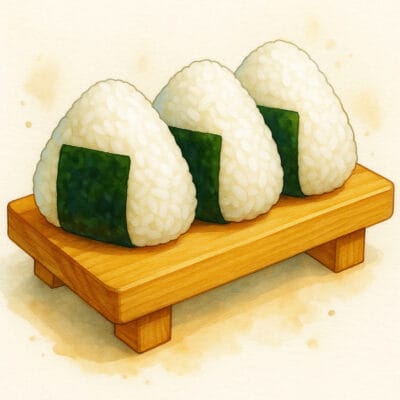Onigiri: A Essência da Comida Portátil Japonesa
O Onigiri, talvez o alimento mais popular no Japão depois do hambúrguer, tem uma história que se estende por mais de um milénio, mas continua tão contemporâneo como a cultura moderna. Estas bolas de arroz surgiram durante o Período Heian (794-1192) como comida portátil para soldados, com a salinidade dos recheios a atuar como um conservante natural. O que torna o Onigiri especial é a sua versatilidade e significado cultural — podem ser triangulares, cilíndricos ou em forma de bola, recheados com tesouros como salmão grelhado, ameixa em conserva ou kombu, e muitas vezes envoltos em alga nori crocante.
Onigiri

Bolas de arroz tradicionais japonesas feitas com arroz temperado, moldadas à mão em triângulos, e muitas vezes recheadas com ingredientes saborosos como salmão ou ameixa em conserva. Um alimento portátil adorado com mais de 1000 anos de história.
Ingredients
- 2 xícaras de arroz japonês de grão curto
- 2.5 xícaras de água
- 1 colher de chá de sal
- 4 folhas de alga nori
- 2 colheres de sopa de salmão grelhado, desfiado
- 2 umeboshi (ameixas em conserva)
- 1 colher de sopa de sementes de gergelim
- 1 colher de sopa de kombu (alga) em molho de soja
Directions
- Lave o arroz até a água sair completamente limpa. Cozinhe o arroz com a água numa panela de arroz ou numa panela normal até ficar macio e fofo.
- Deixe o arroz arrefecer um pouco. Ele deve estar morno, mas manuseável. Tempere o arroz cozido com o sal.
- Molhe as mãos com água salgada para evitar que o arroz grude. Pegue um punhado de arroz, cerca de ½ xícara, e forme uma pequena cavidade no centro.
- Coloque o recheio de sua escolha (salmão, umeboshi ou kombu) no centro da cavidade.
- Cubra com mais um pouco de arroz e comece a moldar o onigiri em um triângulo usando as palmas das mãos, pressionando suavemente, mas com firmeza.
- Envolva o onigiri com uma folha de nori, se desejar, ou polvilhe com sementes de gergelim.
- Sirva imediatamente para desfrutar da alga nori crocante ou envolva em película aderente para o levar como lanche.
- A Escolha do Arroz: A chave para um bom onigiri é usar arroz de grão curto japonês. Ele tem a textura pegajosa certa que ajuda a manter a forma do onigiri.
- Mãos Húmidas: Umedecer as mãos com água salgada não só evita que o arroz grude, mas também adiciona tempero à camada externa.
- Recheios: Além do salmão, umeboshi e kombu, pode experimentar recheios como atum com maionese, frango teriyaki, ou até mesmo carne de porco cozida.
Nutrition
Por Porção: 250 calorias; 2 g de gordura; 50 g de hidratos de carbono; 5 g de proteína; 0 mg de colesterol; 300 mg de sódio.
—
Japanese Onigiri: The Essence of Japanese Portable Food
Onigiri, perhaps the most popular food in Japan after the hamburger, has a history that spans over a millennium, yet remains as contemporary as modern culture itself. These rice balls emerged during the Heian Period (794-1192) as a portable food for soldiers, with the saltiness of the fillings acting as a natural preservative. What makes Onigiri special is their versatility and cultural significance—they can be triangular, cylindrical, or ball-shaped, filled with savory treasures like grilled salmon, pickled plum, or kombu, and are often wrapped in crisp nori seaweed.
Onigiri (おにぎり)

Traditional Japanese rice balls made with seasoned rice, shaped by hand into triangles, and often filled with savory ingredients like salmon or pickled plum. A beloved portable food with over 1000 years of history.
Ingredients
- 2 cups Japanese short-grain rice
- 2.5 cups water
- 1 tsp salt
- 4 pieces nori seaweed sheets
- 2 tbsp grilled salmon, flaked
- 2 umeboshi (pickled plums)
- 1 tbsp sesame seeds
- 1 tbsp kombu (kelp) in soy sauce
Directions
- Rinse the rice until the water runs completely clear. Cook the rice with water in a rice cooker or pot until tender and fluffy.
- Let the rice cool slightly. It should be warm but manageable. Season the cooked rice with salt.
- Wet your hands with salted water to prevent the rice from sticking. Take a handful of rice, about ½ cup, and form a small well in the center.
- Place your chosen filling (salmon, umeboshi, or kombu) in the center of the well.
- Cover with a bit more rice and begin to shape the onigiri into a triangle using your palms, pressing gently but firmly.
- Wrap the onigiri with a sheet of nori, if desired, or sprinkle with sesame seeds.
- Serve immediately to enjoy the crispy nori, or wrap in plastic wrap for later consumption as a snack.
- The Rice Choice: The key to good onigiri is using Japanese short-grain rice. It has the right sticky texture that helps the onigiri hold its shape.
- Wet Hands: Wetting your hands with salt water not only prevents the rice from sticking but also adds seasoning to the outer layer.
- Fillings: In addition to salmon, umeboshi, and kombu, you can try fillings like tuna with mayonnaise, teriyaki chicken, or even simmered pork.
Nutrition
Per Serving: 250 calories; 2 g fat; 50 g carbohydrates; 5 g protein; 0 mg cholesterol; 300 mg sodium.